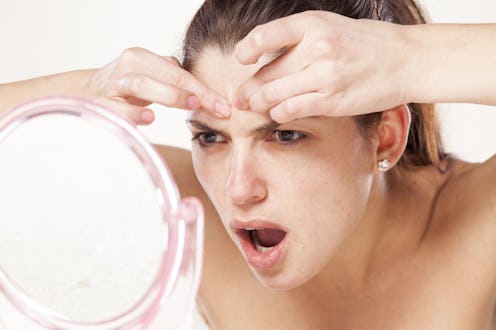Life
Beat Acne by Treating it Based on Type

Where a zit lands on your body is almost completely connected to what kind of acne it is. It's not a correlation I'd put together, until I spoke to famed dermatologist, Dr. Dennis Gross, about why we get pimples in strange places — and more importantly, how to deal.
If you're using the same method for all kinds of acne, you're probably still seeing breakouts — because each type of acne requires a unique type of medication or prevention. If you can identify what type of acne you struggle with, you'll have a better success rate with treatments.
Take a look at these four types of acne, then get the upper hand on your worst breakouts.
Hormonal
While breakouts may seem totally random, they often are “scheduled,” Gross says. It's something you've likely already experienced. Hormonal breakouts generally occur around the mouth, chin, and jaw area, and may routinely get worse the week before your period. If this is the case, proactively treating skin around this time can greatly reduce their severity.
Be consistent with your birth control. Cleanse, treat, use an oil-free moisturizer, and spot treat as needed.
"If you have hormonal acne, I suggest that you take care of your skin with daily preventative measures," Gross says. Prescription remedies for acne may include birth control pills (some are FDA approved to work on acne by controlling hormonal fluctuations). "I’ll also have the patient go for blood work to determine if medication is needed to regulate hormones," he says.
Cystic
Cystic acne occurs when there is a severe infection of bacteria clogging the pore. If bacteria clogs the pore, it leads to whiteheads, pustules, and pimples. Cysts are a more severe extension of whiteheads. Cystic acne is the hardest to get rid of, but can be treated.
You can recognize and distinguish cystic acne as "small boils under the skins surface that are tender and may lead to scarring. Most often, the skin over a cyst is smooth," Gross says.
The best treatment for cysts is prevention — don't let those oil glands become blocked in the first place.
Gross says, "Many people do not realize that a blemish may begin to form two to three weeks before it appears on the surface of the skin. The key to clearing skin is applying a topical treatment that prevents the clogging of the pores with the skin’s own thickened oil all over the face."
L-carnitine is one key ingredient in acne treatments that helps prevent the oil gland blockages (Gross' brand One Step Acne Eliminating Pads includes this and witch hazel). Glycolic and lactic acids help exfoliate the skin and remove dead skin cells from clogging pores.
One Step Acne Eliminating Pads, $38, Sephora
Blackheads
Acne begins as a blocked oil gland (pore), which, according to Gross, is usually the result of what he calls an oil chemistry problem.
When acne occurs, it's because the natural oil is too thick and waxy for its own good. Instead of flowing freely through the pores, it becomes blocked and forms a plug. These clogged pores (aka “flat acne”) may result in the form of blackheads (you'll know blackheads if pores appear to be clogged and a dark brown color), though they may also simply appear as enlarged pores on the skins surface — which is the beginning stages of acne.
Dr. Gross recommends this treatment combo: "Steam, treat, use an oil-free moisturizer, and a pore clearing mask 2-3x a week. Steaming skin at home is a great option to open pores and help get rid of pore-clogging surface debris," he says.
The easiest and most luxurious way to do it is Steamer Solutions, but alternatively you can simply hold your head above a boiling bowl of water. Be sure to exfoliate after steaming — this step is key to detect and kill any remaining acne causing bacteria before moisturizing.
To clear your pores of blackheads, look for products containing salicylic acid and willow bark extract. "Salicylic acid is a beta hydroxy acid that exfoliates, reducing the number of pore blockages, and willow bark extract is salicylic acid’s natural alternative, which helps to effectively clear pores and exfoliate," Dr. Gross says.
Steamer Solutions, $129, Amazon
Whiteheads
When flat acne becomes inflamed or infected, it creates bumpy acne. This is why people typically develop a “whitehead” on a blemish — "it's a reaction of one’s white blood cells flowing to the area to combat the infection," Dr. Gross says. Whiteheads appear as a pustule (white pus in a bump on skin) or a bump (bacteria underneath skin without visible white on surface).
A spot treatment will reduce redness around the infected blemish. The fastest way to get rid of this kind of blemish is with a sulfur-based medication, which dries it out. Why sulfur?
"Sulfur controls the oil that feeds bacteria, thus reducing spots altogether. Sulfur also calms through osmosis to relieve swelling and draws out the infection to flatten the blemish. Once the blemish is flattened and the infection is gone, the redness will begin to subside," Dr. Gross says.
Therapeutic Sulfure Acne Treatment Masque, $27, Amazon
Image: vladimirfloyd/Fotolia